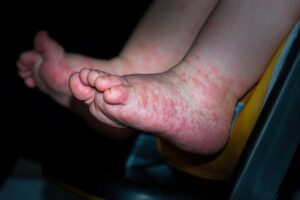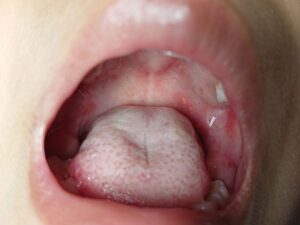What Are Enteroviruses?
As a parent, it can be unsettling when your child suddenly develops a fever or a rash. This guide is designed to provide clear and reassuring information about enteroviruses, a very common group of viruses responsible for several mild illnesses in children. Our goal is to help you confidently identify symptoms, provide effective comfort care at home, and understand when it’s necessary to seek medical advice for your little one.
Enteroviruses are a family of viruses that includes the well-known coxsackievirus. These viruses are a frequent cause of illnesses like Hand, Foot, and Mouth Disease and Herpangina. They are highly contagious and spread easily from person to person, which is why they are so common among young children, especially those in daycare or school settings.





Podcast:
Learn More About Enterovirus
Now, let’s look at the two most common illnesses these viruses cause so you can learn to recognize their specific signs and symptoms.
Common Illnesses Caused by Enteroviruses
While enteroviruses can cause a wide range of symptoms, this guide focuses on two of the most frequent presentations in children: Hand, Foot, and Mouth Disease (HFMD) and Herpangina. Recognizing the distinct symptoms of each illness is the first step toward providing the right kind of comfort and care for your child.
Hand, Foot, and Mouth Disease (HFMD)
What It Looks Like
The signs of HFMD typically include a combination of a rash and mouth sores.
- Rash: You may see a rash of flat spots, raised bumps, or small, fluid-filled blisters. It most commonly appears on the palms of the hands and soles of the feet, but can also show up on the buttocks. Depending on your child’s skin tone, the rash may look red, white, or gray. It is generally not itchy.
- Mouth Sores: Children often develop painful sores in their mouths that begin as blisters and then become ulcers.
Who Is Most at Risk
HFMD is most common in children under 5 years old, particularly those in childcare settings where the virus can spread easily. However, older children and adults can get it, too.
Herpangina
What It Looks Like
Herpangina primarily affects the mouth and throat and is often accompanied by a sudden fever.
- Mouth and Throat Sores: This illness is characterized by small, blister-like sores found specifically in the back of the mouth and throat. These sores can be quite painful and may make swallowing difficult for your child.
- Fever: A high fever is a very common symptom of Herpangina.
Who Is Most at Risk
Herpangina typically affects toddlers and children under 10 years old, especially those who attend school or daycare.
Now that the symptoms of these two common illnesses are clear, let’s review how a healthcare provider typically makes a diagnosis.
At-Home Care: Keeping Your Child Comfortable
There is no specific antiviral medicine for enterovirus infections like HFMD or Herpangina. Instead, the goal of treatment is supportive care—that is, managing the symptoms to keep your child as comfortable as possible while their own immune system fights off the virus.
Here are the most effective ways you can provide comfort at home:
- Manage Pain and Fever: You can use over-the-counter medicines like acetaminophen or ibuprofen to help relieve pain from mouth sores and reduce your child’s fever.
- Encourage Fluids: The painful sores in the mouth and throat can make it difficult to eat or drink. It is crucial to encourage your child to drink plenty of cool fluids, like water, diluted juice, or milk, to prevent dehydration. Popsicles or chilled soft foods can also be soothing and hydrating.
- Soothe a Sore Mouth: Offer soft foods that don’t require much chewing. Avoid giving your child foods that can irritate the mouth sores, such as anything hot, acidic (like citrus juice), spicy, or salty. For older children, a simple salt water rinse can help soothe the mouth. Your doctor may also recommend a topical anesthetic for pain relief.
Recovery: What to Expect
The good news is that these illnesses are usually mild and resolve on their own. Most children feel much better within a week to ten days.
The table below outlines the typical recovery timeline for each illness.
| Illness | Typical Recovery Time |
| Hand, Foot, and Mouth Disease | Generally excellent; most children recover fully in 7-10 days. |
| Herpangina | Symptoms typically resolve within one week. |
An Important Note on Contagion: Enteroviruses can be shed for several weeks even after symptoms resolve, meaning a child may still be contagious.
Preventing the Spread to Others
Because enteroviruses are highly contagious, taking simple preventative steps is crucial, especially in families with other children or for children who attend daycare or school.
- Handwashing: Frequent and thorough handwashing with soap and water is the single most critical step in preventing the spread of infection. Wash your hands after changing diapers or helping a child use the toilet, and encourage your children to wash their hands often throughout the day.
- Cleaning Surfaces and Toys: Regularly disinfect frequently touched surfaces like doorknobs, faucets, and countertops. Clean toys that may have come into contact with saliva.
- Avoiding Sharing: To prevent transmission, avoid sharing cups, eating utensils, towels, or toothbrushes with the sick child.
While most cases are mild, it is always important to know which signs might indicate a more serious problem.
When to See a Dermatologist
Although these illnesses are typically mild and self-limiting, you should always trust your instincts and know the warning signs that may point to a complication. Please contact a provider right away if you notice any of the following:
- Signs of Dehydration: Your child is not urinating for more than 8 hours, has no tears when crying, or has a very dry mouth.
- Unusually High Fever: The fever does not come down with fever-reducing medication or lasts for more than a few days.
- Severe Pain: Your child complains of a severe headache or has neck stiffness.
- Changes in Behavior: Your child seems very sleepy and difficult to wake (lethargic), appears confused, or is unusually irritable.
- Difficulty Breathing.
Navigating common childhood illnesses is a part of parenting, and with enteroviruses, the key is knowing you are well-equipped to handle them. These illnesses are typically mild and pass quickly. Your role is simple but vital: provide comfort, encourage rest and fluids, monitor for any warning signs, and practice good hygiene to protect others. Remember, you are your child’s best advocate, and we are always here to be your partner in their health and well-being.
